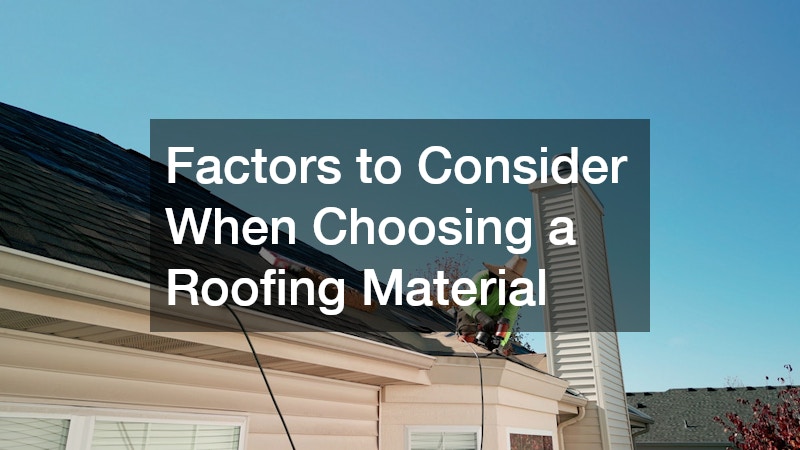Choosing the best roofing material for your home is a big decision. Your roof protects you from the weather, keeps your home energy efficient, and adds to your house’s overall look. But with so many options available, it can be hard to know which one is right for you.
In this guide, we’ll explore popular roofing materials, their benefits, drawbacks, and key factors to consider. By the end, you’ll be better equipped to make an informed choice that fits your budget, climate, and style.
Popular Roofing Materials Explained

Homeowners have several roofing options, each with its own advantages and disadvantages. The most common materials include asphalt shingles, metal, wood, tile, and slate.
Asphalt Shingles
Asphalt shingles are the most widely used roofing material in the United States. They are affordable, easy to install, and come in many colors and styles.
- Pros:
- Low cost and widely available
- Easy to repair or replace
- Available in many colors and textures
- Works well in most climates
- Cons:
- Shorter lifespan (15–30 years)
- Can be damaged by strong winds or hail
- Not very eco-friendly, as they are petroleum-based
Asphalt shingles are a solid choice for homeowners who want a reliable, budget-friendly roof.
Metal Roofing
Metal roofs have grown popular because they last a long time and offer strong protection. Made from steel, aluminum, copper, or zinc, metal roofs are known for their durability and energy efficiency.
- Pros:
- Long lifespan (40–70+ years)
- Resistant to wind, fire, and hail
- Reflects heat, lowering cooling costs
- Lightweight and recyclable
- Cons:
- Higher upfront cost
- Can be noisy during rain without proper insulation
- Installation requires special skills
When weighing your options, you might want to check out the pros and cons of metal roof for a deeper understanding of this popular choice.
Wood Shingles and Shakes
Wood roofs, typically made from cedar, offer a natural and rustic look. Shingles are thin, flat pieces of wood, while shakes are thicker and more textured.
- Pros:
- Attractive and natural appearance
- Good insulation properties
- Can last 25–30 years with proper care
- Cons:
- Requires regular maintenance
- Prone to fire unless treated
- Can be damaged by insects and rot
Wood roofs are ideal for homeowners who want a traditional look and are willing to invest time in maintenance.
Tile Roofing
Tile roofs, made from clay or concrete, are popular in warmer climates, especially Mediterranean or Spanish-style homes. They are heavy but very durable.
- Pros:
- Long lifespan (50+ years)
- Fire-resistant
- Low maintenance
- Energy efficient, keeps homes cooler
- Cons:
- Very heavy; may require additional roof support
- Higher cost and installation complexity
- Fragile and can crack under impact
Tiles add a distinctive style and excellent durability, especially in hot, dry areas.
Slate Roofing
Slate is a natural stone roofing material known for its beauty and incredible lifespan. It’s one of the longest-lasting roofs you can get.
- Pros:
- Extremely durable (75–100+ years)
- Fireproof and environmentally friendly
- Very low maintenance
- Unique and elegant appearance
- Cons:
- Very heavy, requires strong roof framing
- Expensive material and installation costs
- Can be brittle and difficult to repair
Slate is perfect if you want a stunning, long-lasting roof and don’t mind the upfront investment.
Factors to Consider When Choosing a Roofing Material

Choosing the best roofing material goes beyond looks and price. Here are some key things to keep in mind:
- Climate: Different roofs handle weather differently. For example, metal roofs are great for snowy or fire-prone areas, while tile works well in hot climates.
- Budget: Your budget affects both the initial cost and the roof’s lifespan. Sometimes paying more upfront means fewer repairs and replacements later.
- Durability: Consider how long you plan to stay in your home. Durable roofs like metal, tile, and slate last decades, while asphalt needs replacing more often.
- Maintenance: Some roofing materials require regular care to stay in good condition. Know how much time and money you’re willing to spend.
- Energy Efficiency: Roofs that reflect sunlight or provide better insulation can lower heating and cooling bills. Metal and tile roofs often perform best in this area.
- Style: Choose a roofing style that complements your home’s architecture and boosts curb appeal.
Installation and Lifespan Overview
The quality of your roof’s installation plays a crucial role in how well it performs and how long it lasts. No matter which roofing material you choose, hiring experienced and skilled contractors ensures the job is done right the first time. Proper installation helps prevent common problems like leaks, poor ventilation, and premature wear that can shorten your roof’s life.
Here’s a closer look at the average lifespans of popular roofing materials, along with a few installation tips to keep in mind:
- Asphalt Shingles: 15–30 Years
Asphalt shingles are the most common roofing material in the U.S., partly because they are easy and quick to install. However, their lifespan can vary depending on the quality of shingles used and installation expertise. Proper underlayment and good ventilation are key to maximizing their lifespan. Poor installation can lead to issues like curling or cracking shingles and leaks.
- Metal Roofing: 40–70+ Years
Metal roofs are known for their durability and longevity. Because they come in large panels, installation requires specialized skills and tools. Fasteners must be securely attached, and seams properly sealed to prevent leaks. A well-installed metal roof can last over 70 years, but poor installation can cause issues with expansion, contraction, and noise.
- Wood Shingles: 25–30 Years
Wood shingles offer a natural, warm appearance but need expert installation to ensure proper spacing and ventilation. Without good airflow, wood roofs are more prone to moisture buildup and rot. The quality of wood and treatment against pests and fire also affects how long the roof lasts.
- Tile Roofing: 50+ Years
Tile roofs are heavy and require reinforced roof framing. Installation must be precise to properly align tiles and prevent cracking. Because tiles are brittle, care must be taken during installation to avoid damage. When installed correctly, tile roofs can last well over 50 years with minimal maintenance.
- Slate Roofing: 75–100+ Years
Slate is one of the longest-lasting roofing materials but is also the most difficult to install. Slate tiles are heavy and fragile, requiring skilled roofers to ensure they are securely fastened and properly overlapped. Due to its weight, your home’s structure must be able to support a slate roof. Proper installation can allow slate roofs to last over a century.
Key Installation Tips:
- Always hire licensed and insured roofing contractors with experience in your chosen material.
- Ask for references and examples of past work.
- Ensure the contractor follows local building codes and manufacturer guidelines.
- Proper underlayment, ventilation, and flashing installation are critical for all roofs.
- Schedule regular roof inspections to catch any installation issues early.
Taking the time to select the right contractor and focusing on quality installation will maximize your roof’s lifespan and protect your home for years to come.
Environmental Impact of Roofing Materials
Sustainability is an important factor for many homeowners. Here’s how common materials stack up:
- Asphalt shingles: Not recyclable and petroleum-based.
- Metal roofing: Often made from recycled materials and 100% recyclable.
- Wood: Renewable but can contribute to deforestation if not sourced responsibly.
- Tile and slate: Natural materials with low environmental impact but energy-intensive to produce.
Final Thoughts: Finding the Best Roof for Your Home
There’s no one-size-fits-all answer to what the best roofing material is. It depends on your budget, location, home style, and personal preferences.
- If you want an affordable, versatile option, asphalt shingles are hard to beat.
- For long-lasting durability and energy savings, metal roofing is a smart choice (don’t forget to review the pros and cons of metal roof).
- If style and tradition matter most, wood or slate roofs offer classic beauty.
- Tile roofs are ideal for warm climates where cooling efficiency matters.
By considering all these factors and talking with professional roofing contractors, you can pick the best roofing material to protect and enhance your home for years to come.
